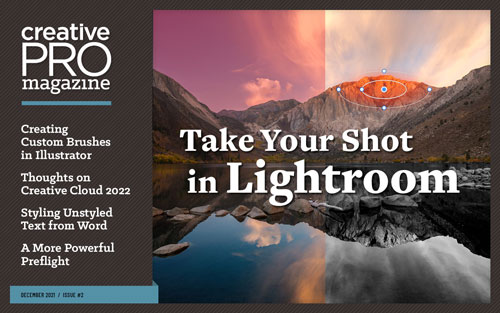Adobe MAX 2021: Larger Forces at Work
A look at everything new in Creative Cloud apps and services, and the strategy driving them

This article appears in Issue 2 of CreativePro Magazine.
 This article appeared in Issue 2 of CreativePro Magazine.
This article appeared in Issue 2 of CreativePro Magazine.Every autumn, the Adobe MAX conference brings a wave of major upgrades across Creative Cloud products and services. Adobe then supports the new releases on the conference side, with three days of sessions that are educational, inspirational, and, of course, promotional. The traditional way to process Adobe MAX is to look for the list of what’s changed in your favorite application, such as Photoshop. Increasingly, it’s just as important to step back and look at where Adobe is steering Creative Cloud as a whole, because the implications resonate through nearly all Creative Cloud desktop and mobile apps, typically affecting the ones you use the most.
A Quick Recap of the 2022 Releases
Let’s first review some of the key changes in the 2022 releases in Creative Cloud applications that are more familiar to CreativePro readers.
Photography and digital art: Adobe Photoshop and Adobe Fresco
In the 2022 release of Adobe Photoshop, what might save you the most time is the Object Finder enhancement to the Object Selection tool. You no longer have to drag a selection marquee around a subject. Simply hover the pointer over potential subjects, and Object Finder highlights them individually (Figure 1). Click when the subject you want is highlighted, and Photoshop creates a precise selection of it. Modifier keys let you click to select multiple subjects, and a Mask All Objects command instantly generates layer masks for every subject detected.

Object Selection Tool and foreground duck colored in blue mask. Third image shows one other duck in flock colored in blue mask. Fourth image shows Show All Objects tool highlighted in toolbar, and all ducks highlighted in blue mask.” width=”600″ height=”485″> Figure 1. When Object Finder is active in Photoshop, target an automatically found object by hovering the pointer over it; click to convert a highlight into a selection.

Figure 2. Color Transfer, a beta Neural Filter in Photoshop, lets you apply the colors of one image to another.
Photography: Adobe Camera Raw, Adobe Lightroom Classic, Adobe Lightroom
For the 2022 releases of Adobe’s photo-processing applications, the standout feature is the Masks panel (Figure 3), the new home for greatly improved local adjustments. The entire local adjustment workflow is redesigned for better precision, control, and organization, and it adds two AI-powered options previously seen in Photoshop: Select Subject and Select Sky. These new options make it much more likely that you can complete corrections in Camera Raw or Lightroom, instead of having to convert and manage a copy of the image as a Photoshop document that takes up much more storage space. However, they don’t do any compositing—that’s still Photoshop territory.

Figure 3. The Masks panel is a serious upgrade for local adjustments in Camera Raw, Lightroom Classic (shown), and Lightroom.
Graphic design: Adobe Illustrator and Adobe InDesign
In the 2022 release of Illustrator, the 3D effects are improved, including a new ray-traced rendering option, and you can apply Substance 3D materials (Figure 4). Illustrator also adds Share for Commenting; if you have already used Share for Review in InDesign and Acrobat, you already know how this works.

Figure 4. Illustrator improves its 3D features and adds support for Substance 3D materials.

Figure 5. In InDesign, you can sample color themes, shapes, and type from images by using the Extract from Image command.
Video and visual effects: Adobe Premiere Pro and Adobe After Effects
The 2022 releases of Adobe video applications respond to emerging needs. It’s increasingly important for social media video to show captions for folks who watch on their smartphones with the sound muted. The 2022 release of Adobe Premiere Pro includes an improved Speech to Text feature (Figure 6), which automatically transcribes dialogue to editable text. You can convert that text to open (visible) captions, and then style it to match your branding. A new Simplify Sequence feature makes it easier to clean up the parts of a sequence that you no longer need, but which clutter the Timeline panel.

Figure 6. In Premiere Pro, automatically transcribe dialogue and convert to captions using improved Speech to Text.

Figure 7. In After Effects, the growing green line in the timeline shows preview frames being rendered in advance around the current frame, during idle time.
What’s Driving the 2022 Creative Cloud Releases
It’s natural to first look at changes by application, especially if you work mostly in one or two Adobe applications. Creative Cloud is a system intended to integrate many applications and services, however, so it’s important to consider the larger priorities Adobe is advancing throughout Creative Cloud. They drive the changes that actually happen to the individual applications.
New hardware, new code
Adobe flagship applications, such as InDesign, Photoshop, Illustrator, and After Effects, got their start 20 to 30 years ago. Of course, they’ve all been brought forward to stay compatible with the numerous changes in the macOS and Windows operating systems. But it’s taken longer to fully optimize them for the hardware advances of recent years, such as the increasing number of CPU and GPU cores, as well as Retina/HiDPI displays. This work continues in the 2022 release of Creative Cloud desktop apps. Adobe replaced the Photoshop graphics engine with a modern one called Native Canvas, which makes better use of current graphics hardware. A new type engine provides unified support for languages and scripts worldwide. And a new Technology Previews preference setting (Figure 8) supports HDR displays, such as the Liquid Retina XDR displays on the new MacBook Pro models powered by the M1 Pro and M1 Max processors. The new UI scaling feature in InDesign takes better advantage of Retina/HiDPI display resolution.

Figure 8. A new Technology Previews preference in Photoshop supports precise color management on a true HDR display.
Collaborating anywhere, with anyone
Adobe continues to unify and advance collaborative workflows in the cloud, which you may have noticed with the earlier introduction of Share for Review online features in Acrobat and InDesign. Cloud-based review has many benefits. You don’t have to manage sending and receiving large documents though email or storage services, and no reviewer has to install software. Everybody gets a link, and they can do the review with the actual document in a web browser, while you sit back and get notifications when they make comments. Adobe is expanding the Share for Review experience to more apps. That’s why Photoshop and Illustrator now include Share for Review/Share for Commenting features in their 2022 releases, and the experience is consistent with Acrobat and InDesign. These review features are also in the iPad versions of Photoshop (Figure 9) and (in private beta) Illustrator, so they also work consistently across desktop and mobile apps.

Figure 9. In Photoshop for iPad, the Share option works the same way as it does on a desktop computer. You can enable an option to allow comments.
Creativity on any platform
Popular platform-independent solutions, such as Google Docs and social media apps, created an expectation that it should be easy to look at and edit a document on whatever device is at hand, whether it’s a desktop or laptop computer, tablet, or smartphone. The days when a new application was desktop-only or desktop-first are receding, and Creative Cloud applications follow that trend. Up to now we’ve seen a little bit here and a little bit there, but with the 2022 release of Creative Cloud, the long-term Adobe vision is becoming clearer. The way Lightroom added the new masked adjustments feature is an example of enabling creativity anywhere. This feature was made available simultaneously on Lightroom desktop, tablet, and phone apps, as well as Lightroom Classic, though not yet in the Lightroom web app. To be able to apply precise AI-based subject masks on a computer is one thing; it’s a little more remarkable to be able to do it on your smartphone while standing at the bus stop… and then to see those edits sync right back to your computer where you can perfect them. More Adobe applications are following the lead of Lightroom, which lets you edit on desktop and mobile devices as well as within a web browser. Web browser versions of Photoshop (Figure 10) and Illustrator are available in beta. But set your expectations properly: These web-based versions are based on the Photoshop and Illustrator mobile apps, so they don’t have all of the features of the desktop apps.

Figure 10. A new beta version of Photoshop runs in a supported web browser.
Accelerating your work with machine learning
The Adobe machine learning engine, Adobe Sensei, continues to be a rich source of new capabilities. This will only continue as more desktop and mobile devices integrate hardware acceleration for machine learning, such as the Neural Engine in Apple devices (using Apple CoreML) and the Tensor Cores in NVIDIA GPUs (using Microsoft Windows ML). Machine learning is the foundation of such new Adobe features as the convenient Object Finder and surprising Neural Filters in Photoshop, the Select Subject and Select Sky automatic selection features already in Photoshop and now added to Lightroom and Lightroom Classic, and the Speech to Text feature in Adobe Premiere Pro. Adobe Stock increasingly uses machine learning to help you find media, such as in the new Find Similar Audio feature (drop an audio track into search, and it looks for similar-sounding audio for you to license).
Extending into the third dimension
Adobe is expanding 3D support across Creative Cloud apps. One of the biggest steps was the recent acquisition of Substance 3D, a suite of applications that tackle different aspects of 3D authoring. That happened before MAX 2021, but it signifies a push into better support of 3D and augmented reality (AR) workflows, as 3D and AR become increasingly important for everything from gaming to online retail sales. The effects of this effort are currently uneven across Adobe applications. Illustrator added the ability to apply Substance 3D materials in its 3D panel, and After Effects recently upgraded its 3D controls. Photoshop is deprecating (dropping support for) its current 3D feature set, however, because its code is too old to take advantage of today’s graphics hardware. Plus, Adobe has not yet announced how Photoshop 3D support will be modernized. Will it be an overhauled version of the current 3D features, a different feature set, or an integration with Substance 3D? An issue many users currently have with Substance 3D is that it is a separate subscription, not included with the Creative Cloud “All Apps” plan.
Seeing Through the Creative Cloud
The Adobe vision for Creative Cloud might seem unclear at first. But if you step back to get a better view of the changes across the 2022 releases of Creative Cloud applications, it’s easier to see the larger Adobe strategy across apps and platforms. How you respond to this depends on how well your priorities are aligned with Adobe. If you mostly work in one desktop application on your own, you might wish that development was more focused on application-specific features on the desktop. The more your work depends on rapid work-anywhere iteration and delivery on the latest desktop and mobile hardware, or collaboration with colleagues, the more the 2022 release of Creative Cloud will support your work.
Commenting is easier and faster when you're logged in!
Recommended for you

InStep: Creating Mosaic Tile Effects with Illustrator & Photoshop
Learn to use Illustrator and Photoshop to create custom text with subway mosaic...

Making a 3D Rainbow in Illustrator
Explore the amazing things you can do with Illustrator’s 3D and Materials panel




